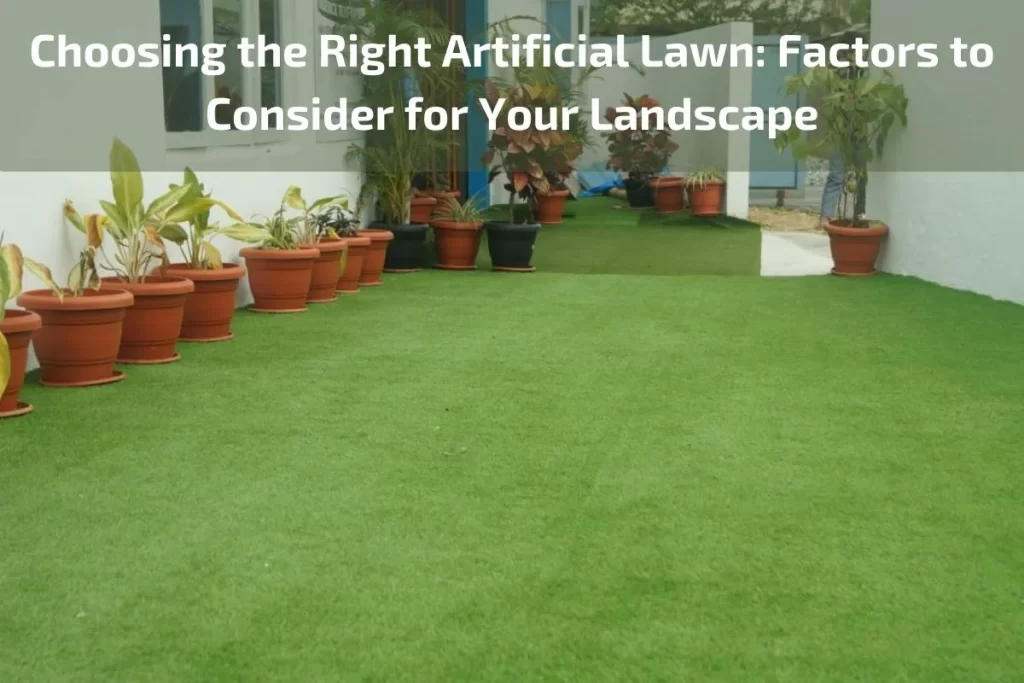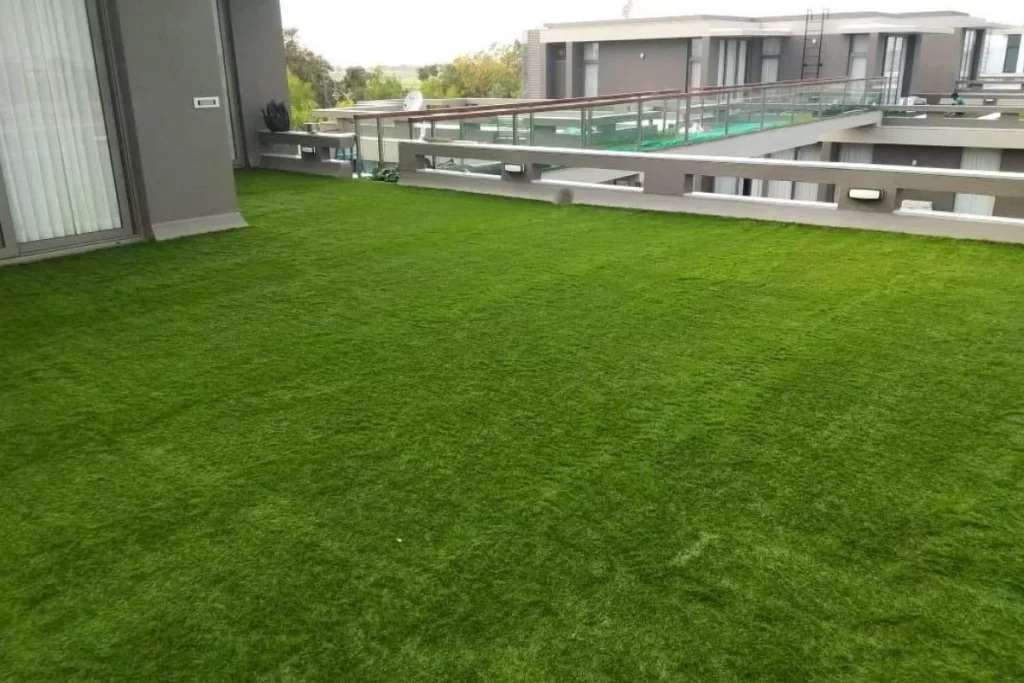
Choosing the right artificial lawn for your landscape is a significant decision that can transform the appearance, functionality, and maintenance requirements of your outdoor space. With advancements in synthetic turf technology and a wide range of options available on the market, homeowners and property managers have the opportunity to create stunning and sustainable landscapes that enhance curb appeal and promote environmental conservation.
In this guide, we will explore the key factors to consider when selecting an artificial lawn for your landscape. From assessing your specific needs and preferences to understanding the characteristics of synthetic turf products, we’ll provide valuable insights to help you make informed decisions that align with your aesthetic vision, lifestyle, and budget.
Definition and Composition of Artificial Lawns
Artificial lawns, also known as synthetic turf or fake grass, are engineered surfaces designed to resemble natural grass without the need for constant maintenance. These surfaces are made from a combination of synthetic materials carefully selected to mimic the look and feel of real grass.
Synthetic Fibers:
Artificial lawns consist of synthetic fibers, typically made from materials such as polyethylene (PE) or polypropylene (PP). These fibers are manufactured to replicate the texture, color, and resilience of natural grass blades.
Backing Material:
The synthetic fibers of artificial lawns are attached to a backing material, which provides stability and support for the turf surface. Backing materials are often made of polyurethane (PU) or latex, both of which offer durability and resistance to environmental elements.
Infill Material (Optional):
Some artificial lawns include infill material, which is spread over the turf surface to provide weight, stability, and cushioning. Common infill materials include silica sand, crumb rubber, or a combination of both. Infill materials help to maintain the integrity of the turf fibers and enhance performance during activities.
Base Layers (Optional):
Depending on the installation method and intended use, artificial lawns may include base layers beneath the turf surface. Base layers typically consist of compacted aggregate materials, such as crushed stone or decomposed granite, which provide drainage and stability for the turf system.
Drainage System:
Proper drainage is essential for artificial lawns to prevent water accumulation and promote longevity. Drainage systems are integrated into the base layers of the turf installation, allowing water to flow freely through the turf and away from the surface.
Benefits of Artificial Lawns
Artificial lawns offer a multitude of advantages that make them a preferred choice for homeowners, businesses, and communities seeking beautiful, low-maintenance landscapes. From reducing water consumption to enhancing curb appeal, artificial lawns provide numerous benefits that contribute to sustainable and enjoyable outdoor spaces. Here are some key advantages of artificial lawns:
Low-Maintenance Landscaping:
Elimination of Mowing: Unlike natural grass, artificial lawns do not require regular mowing to maintain their appearance. This saves homeowners time, effort, and the cost of lawn maintenance equipment.
Minimal Watering: Synthetic turf does not need regular watering to stay green and lush, resulting in significant water savings and lower water bills.
No Fertilizers or Pesticides: Artificial lawns eliminate the need for fertilizers, pesticides, and herbicides, reducing chemical usage and promoting a safer environment for children, pets, and wildlife.
Year-Round Beauty:
Consistent Appearance: Artificial lawns maintain their vibrant green color and uniform appearance throughout the year, regardless of seasonal changes or weather conditions.
Resilience to Wear and Tear: Synthetic turf is engineered to withstand heavy use and foot traffic without becoming worn or patchy, making it ideal for high-traffic areas and recreational spaces.
Durability and Longevity:
High-Quality Materials: Artificial lawns are constructed from durable synthetic fibers and backing materials designed to withstand UV exposure, foot traffic, and environmental elements.
Long Lifespan: With proper installation and maintenance, artificial lawns can last for many years, providing homeowners and businesses with a long-term landscaping solution that retains its aesthetic appeal and functionality.
Water Conservation: By eliminating the need for regular watering, artificial lawns help conserve water resources, particularly in regions prone to drought or water restrictions.
Reduced Carbon Footprint: Synthetic turf reduces greenhouse gas emissions associated with lawn maintenance equipment, such as lawn mowers and trimmers.
Preservation of Natural Resources: Artificial lawns reduce the demand for natural resources, such as water and fossil fuels, used in the production and maintenance of traditional grass lawns.
Allergy-Friendly Landscaping:
Pollen-Free Environment: Artificial lawns create a pollen-free outdoor space, making them ideal for individuals with allergies or respiratory sensitivities.
Reduced Allergens: Synthetic turf minimizes the presence of allergens such as pollen, grass clippings, and mold spores, creating a cleaner and healthier environment for outdoor activities.

Choosing the Right Artificial Lawn
Selecting the perfect artificial lawn for your landscape is a crucial decision that can significantly impact the aesthetics, functionality, and longevity of your outdoor space. With a wide array of synthetic turf options available on the market, it’s essential to consider several key factors to ensure that you choose the right artificial lawn to meet your specific needs and preferences. Here are some important considerations to keep in mind when selecting an artificial lawn:
Quality and Durability:
Evaluate the Quality: Look for artificial lawns made from high-quality materials, including durable synthetic fibers and robust backing materials, to ensure longevity and resilience against wear and tear.
Assess Durability: Consider the intended use and foot traffic levels of your landscape to choose an artificial lawn that can withstand heavy use without losing its appearance or structural integrity.
Appearance and Realism:
Natural-Looking Fibers: Opt for artificial lawns with synthetic fibers that closely resemble the color, texture, and shape of real grass blades to achieve a natural and realistic appearance.
Variation in Color and Texture: Choose a synthetic turf product that offers variation in color and texture to mimic the visual depth and dimensionality of natural grass, enhancing the overall aesthetic appeal of your landscape.
Pile Height and Density:
Consider Pile Height: Select the appropriate pile height based on your desired aesthetic preferences and maintenance expectations. Shorter pile heights may require less grooming but may sacrifice softness, while longer pile heights offer a lush appearance but may require more upkeep.
Assess Density: Look for artificial lawns with high-density turf fibers to create a fuller and more resilient surface that maintains its shape and structure over time.
Drainage Capability:
Evaluate Drainage System: Ensure that the artificial lawn features an efficient drainage system that allows water to drain quickly and effectively, preventing water pooling and promoting a dry and safe surface.
Consider Environmental Factors: Take into account local climate conditions, rainfall patterns, and soil composition to choose an artificial lawn with the appropriate drainage capabilities for your landscape.
Warranty and Maintenance Requirements:
Review Warranty Coverage: Investigate the warranty offered by the manufacturer to understand coverage for defects, fading, and structural issues, ensuring peace of mind and protection for your investment.
Understand Maintenance Needs: Familiarize yourself with the recommended maintenance practices for the artificial lawn, including brushing, grooming, and periodic cleaning, to ensure optimal performance and longevity.
The Environmental Impact of Artificial Lawns
Artificial lawns have gained popularity as an alternative to traditional grass landscapes due to their low-maintenance nature and year-round aesthetic appeal. While synthetic turf offers numerous benefits, including water conservation and reduced maintenance requirements, it is essential to consider its environmental impact to make informed decisions about landscaping choices. Here, we examine the environmental implications of artificial lawns:
Water Conservation:
One of the primary environmental benefits of artificial lawns is water conservation. Unlike natural grass, which requires regular watering to maintain its lush appearance, synthetic turf does not need irrigation. By eliminating the need for watering, artificial lawns help conserve significant amounts of water, particularly in regions facing water scarcity or drought conditions.
Reduction of Chemical Usage:
Artificial lawns eliminate the need for chemical fertilizers, pesticides, and herbicides commonly used to maintain natural grass landscapes. By reducing chemical usage, synthetic turf helps minimize environmental pollution and contamination of soil, waterways, and ecosystems. Additionally, it promotes a safer and healthier outdoor environment for humans, pets, and wildlife.
Preservation of Natural Resources:
Traditional grass lawns require resources such as water, fertilizer, and fuel for maintenance equipment, contributing to environmental degradation and resource depletion. Artificial lawns reduce the demand for these natural resources, conserving water and reducing carbon emissions associated with lawn care activities. Moreover, synthetic turf extends the lifespan of lawns, minimizing the need for resource-intensive lawn replacements and renovations.
Environmental Concerns of Synthetic Materials:
Despite their environmental benefits, artificial lawns raise concerns about the environmental impact of synthetic materials used in their production. Synthetic turf is typically made from polyethylene (PE) or polypropylene (PP) fibers, which are derived from petroleum-based sources. The manufacturing process of synthetic turf involves energy consumption and emissions of greenhouse gases, contributing to carbon footprints associated with the production and transportation of artificial lawns.
End-of-Life Disposal:
Disposal of artificial lawns at the end of their lifespan poses environmental challenges. Synthetic turf materials are non-biodegradable and may accumulate in landfills, occupying valuable space and contributing to environmental pollution. While efforts are underway to develop recycling and repurposing solutions for synthetic turf materials, effective waste management strategies for artificial lawns remain a concern.

Maintenance Tips and Best Practices of Artificial Lawns
Proper maintenance is essential for preserving the appearance, performance, and longevity of artificial lawns. While synthetic turf requires less maintenance compared to natural grass, regular care and attention are still necessary to ensure optimal aesthetics and functionality. Here are some maintenance tips and best practices for artificial lawns:
Regular Cleaning:
Remove Debris: Use a leaf blower, stiff-bristled broom, or vacuum with a brush attachment to remove leaves, twigs, and other debris from the surface of the artificial lawn regularly.
Pet Waste Removal: Promptly remove solid pet waste from the turf and rinse the affected area with water to prevent odor and staining. Use enzyme-based cleaners to neutralize pet odors effectively.
Weed Control: Inspect the artificial lawn for weed growth and manually remove any weeds or unwanted vegetation to maintain a clean and uniform appearance.
Brushing and Grooming:
Brush Regularly: Use a stiff-bristled brush or power broom to brush the turf fibers against the grain periodically. This helps to lift and fluff up the fibers, preventing matting and maintaining a natural appearance.
Grooming: Use a specialized grooming rake or brush designed for synthetic turf to remove debris, redistribute infill material, and enhance the resilience and uniformity of the turf surface.
Stain Removal and Odor Control:
Address Spills Immediately: Clean up spills and stains on the artificial lawn promptly by rinsing the affected area with water and mild detergent. Avoid using harsh chemicals or bleach, as they may damage the turf fibers.
Pet Odor Neutralizers: Apply pet odor neutralizers or enzyme-based cleaners to eliminate pet odors and prevent bacterial growth in areas frequented by pets.
Inspections and Repairs:
Regular Inspections: Conduct routine inspections of the artificial lawn to identify signs of wear, damage, or seam separation. Pay attention to areas of high foot traffic or potential drainage issues.
Seam Repairs: Inspect the seams of the artificial lawn for signs of separation or lifting. If necessary, reapply adhesive tape or glue to reinforce the seams and prevent further damage.
Addressing Turf Fibers: Trim any loose or frayed turf fibers to maintain a neat and uniform appearance across the entire lawn surface.
Seasonal Maintenance:
Spring Cleaning: Conduct a thorough spring cleaning of the artificial lawn, including brushing, grooming, and inspecting for any winter damage or debris buildup.
Fall Maintenance: Remove fallen leaves, pine needles, and other organic matter from the turf surface to prevent moisture retention and mold growth during the winter months.
Winter Precautions: Minimize foot traffic on the artificial lawn during the winter season to prevent compaction and damage to the turf fibers. Use caution when removing snow and ice to avoid damaging the synthetic turf.
Conclusion
In conclusion, maintaining artificial lawns requires a combination of regular cleaning, brushing, grooming, and proactive inspections to ensure optimal aesthetics, performance, and longevity. By following these maintenance tips and best practices, homeowners, businesses, and communities can enjoy the numerous benefits of artificial lawns while minimizing the need for water, chemical inputs, and labor-intensive care associated with natural grass landscapes.


